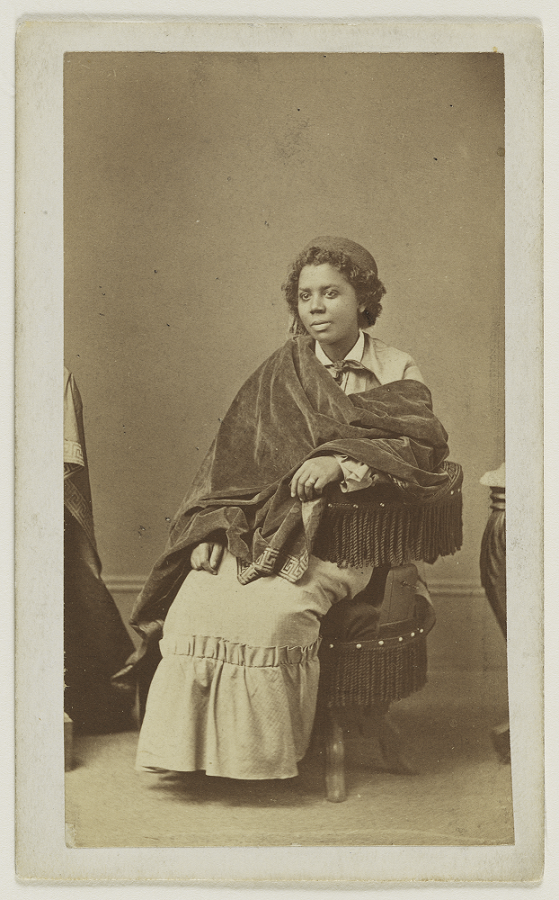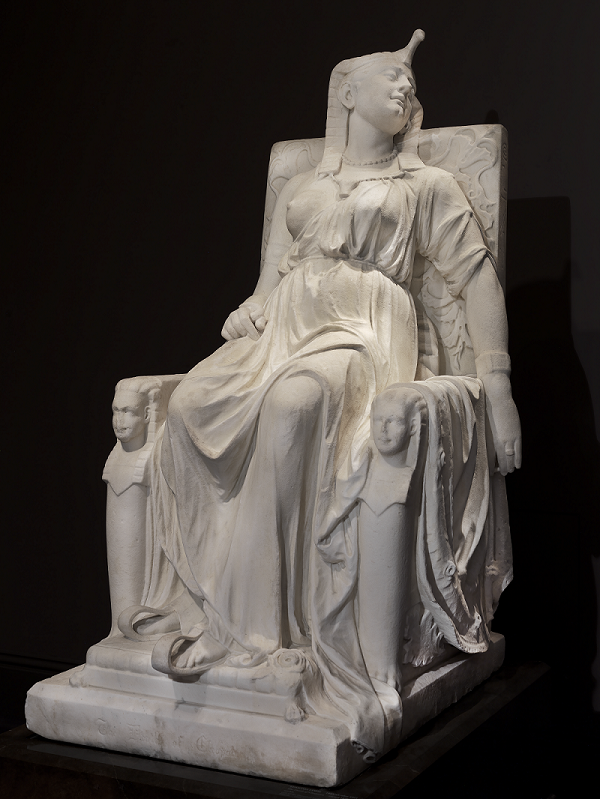Mary Edmonia Lewis was born in 1844 and was initially given the name Wildfire. It is unclear if she was born in Ohio or New York.
Her mother was a Chippewa artist who sold items inspired by her Indigenous culture to tourists. Her father was a free Black man who immigrated from the West Indies and worked in domestic service. Both of her parents died by the time Edmonia was five years old.
After her parents’ deaths, Edmonia lived with family in Niagara Falls, New York. Edmonia’s half-brother made a fortune for himself during the Gold Rush and paid for her education. Edmonia attended a school run by Black nuns in Baltimore and high school in upstate New York.
Edmonia enrolled at Oberlin College at a time when it was uncommon for women, particularly Black women, to pursue higher education. Oberlin was known for its focus on racial and gender equality. It was the first college to allow women and non-white students to attend with white male students. Despite these progressive admission practices, Oberlin required women to follow a different curriculum.
Edmonia, one of a handful of students of color, regularly faced racism at Oberlin. In 1862, two white students accused her of trying to poison them. The university investigated and ruled that Edmonia was innocent. Shortly after, a group of white men kidnapped her and almost beat her to death. They left her in a field in the middle of winter. Edmonia barely survived the attack and suffered major injuries. Such racist attacks continued, and Edmonia eventually left Oberlin without a degree after she was accused of stealing art supplies. It is unclear if the school forced her to leave or if she made the decision herself.
Edmonia wanted to follow in her mother’s footsteps and become an artist. After leaving Oberlin, she moved to Boston where she studied sculpture. As a Black woman, Edmonia was regularly excluded from opportunities to study sculpting. Anatomy classes, where sculptors studied the human body, were only open to white men. Eventually, she found a white male sculptor who recognized her talent and became her mentor.
Her first works were small portrait medallions of famous American abolitionists. During the Civil War, many supporters of the cause were interested in purchasing artworks that depicted leaders in the movement. This made Edmonia’s works particularly popular. In 1864, she made a bust of Colonel Robert Shaw. Colonel Shaw was a white Union officer in charge of an infantry of Black soldiers. After he was killed in battle and buried in a mass grave with his Black infantrymen, he became a famous figure in abolitionist circles.
In 1865, Edmonia moved to Europe with the money she made from selling copies of the bust of Shaw. She visited London, Paris, Florence, and Rome. While in Rome, she found a community of American artists and decided to stay there. As a Black woman in Europe, she found that she had more opportunities to study and create sculptures. Sculptors were almost all white men, but Edmonia proved that a Black woman could build a successful career as an artist.
“Sometimes the times were dark and the outlook was lonesome, but where there is a will, there is a way. I pitched in and dug at my work until now I am where I am.”
The studio where Edmonia worked became a popular stop for American tourists. Even though she lived in Europe, she continued to make sculptures of famous Americans. It is believed that Ulysses S. Grant posed for her.
At the time, Edmonia was one of the few sculptors who completed the entire process of making a sculpture on her own. Other sculptors created small models of their work and hired workers to complete the final product in marble. Edmonia wanted to preserve originality in her sculptures and retain control over her work. However, she also struggled financially and could not afford to hire workers.
Edmonia presented herself as an engaging storyteller, which captured the interest of the public. She often exaggerated or invented stories about her life. Because of this, many details of her life are unclear or unknown.
The largest sculpture Edmonia made is called The Death of Cleopatra, which took her four years to complete. The piece depicts Cleopatra shortly after allowing a poisonous snake to bite her as a way to commit suicide. This depiction was unusual because most artworks represent Cleopatra alive. Edmonia wanted to show Cleopatra controlling her own death and having power over her narrative.
To fund her artwork, Edmonia traveled back to the United States several times to sell sculptures she created. When she finished her Cleopatra work in 1876, the 3,000-pound sculpture was shipped from Rome to Philadelphia to be displayed at the Centennial Exhibition. The sculpture was controversial because it showed Cleopatra with exposed breasts.
Despite being regarded as a masterpiece by many art critics, The Death of Cleopatra did not find a buyer after the exhibition. At the time, artworks by Black women were often not considered important enough to purchase or preserve. For decades, it was displayed in a Chicago suburb at a horse racing track that eventually became a mail center. In the 1980s, it was rediscovered as an important artwork. The sculpture was covered in graffiti and paint. The sculpture is now recognized as a noteworthy work by an American artist and is on display at the Smithsonian American Art Museum. Many of Edmonia’s other works are still lost.
As a sculptor of Indigenous and Black descent, Edmonia also created many works that reflected her heritage. Unlike works created by white artists, her depictions of Indigenous communities were intended to be respectful of their cultures.
In the 1880s, Edmonia became more reclusive. Not much is known about the last decades of her life. Mary Edmonia “Wildfire” Lewis died in London on September 17, 1907.
Vocabulary
- abolitionists: People who want to end slavery.
- anatomy: The study of the human body.
- Centennial Exhibition: International exhibition that marked the 100th anniversary of the Declaration of Independence.
- portrait medallions: Small circular sculptures with portraits of famous people.
Discussion Questions
- How do you think Edmonia’s early experiences at home and in school shaped her life?
- What challenges did Edmonia Lewis face as a Black and Indigenous woman sculptor?
- Why do you think Edmonia Lewis exaggerated stories about her own life? Why might it have been important for her to market herself as an interesting person?
- Why were some of Edmonia Lewis’s most famous works lost? What does this tell you about women artists of color and their legacies?
Suggested Activities
- Have students create portrait medallions inspired by the work of Edmonia Lewis.
- Examine the work of Augusta Savage, another Black female sculptor. How does her work compare with Edmonia Lewis’s?
- Explore Black women’s activism during this time period by combining this resource with Ida B. Wells’s article about Jim Crow, a speech from the first Black women’s club convention, and the life stories of Lucy Parsons and Josephine St. Pierre Ruffin.
- Explore female artists by combining this life story with paintings by Mary Cassatt, and the life stories of Edith Wharton, María Ruiz de Burton, and Queen Lili’uokalani.
- For a larger lesson on the experiences of Black women during this time period, combine this life story with resources about Black domestic workers, convict laborers, a strike at an Atlanta factory, images of Exodusters, Ida B. Wells’s article about Jim Crow, and the life stories of Josephine St. Pierre Ruffin, Mary Ellen Pleasant, and Lucy Parsons.
Themes
AMERICAN CULTURE








